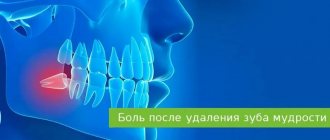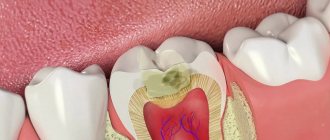Many people are familiar with the phenomenon of gumboil - when the cheek next to a sore tooth swells literally before our eyes and painkillers do not relieve acute pain. This is the periosteum of the tooth becoming inflamed, or, as doctors say, odontogenic periostitis of the jaws has developed. This disease in itself is a complication of dental problems (periodontitis, periodontitis), but in the absence of proper treatment, such inflammation can also cause the development of even more serious complications.
Why can the periosteum of a tooth become inflamed?
The most common is odontogenic periostitis of the jaws, that is, an inflammatory process provoked by diseases of the teeth or periodontal tissues. Deep caries, pulpitis, periodontitis (inflammatory process at the apex of the tooth root), periodontitis - all these diseases, if not treated in time, lead to the appearance of gumboil. Also, one of the reasons for the development of the inflammatory process may be alveolitis - inflammation of the tooth socket, which in some cases occurs after tooth extraction. Inflammation of the periosteum after tooth extraction usually develops in those patients who do not rush to see a dentist when the first signs of complications appear in the postoperative period.
Much less common is toxic periostitis, caused by infection through the blood or lymph (usually due to some general infectious disease). The disease can also be caused by injuries to the jaw bone or surrounding soft tissue.
Tooth hurts after nerve removal and filling
Only a dentist after an examination will help you figure out why a tooth hurts after removing a nerve and filling its canals. Treating teeth on your own without a diagnosis is highly discouraged.
In dental practice, the procedure for treating tooth canals by removing a nerve is a rather complex manipulation. Cases of medical error are common. They are fraught with various complications, in which the filled tooth continues to hurt.
The main reason why a “dead tooth” (without a nerve) is bothersome is:
- removal of the filling material beyond the apex of the tooth - this occurs due to incorrect definition
- working tooth length;
- the doctor filled the canal incorrectly;
- a tool broke off in the canal;
- root perforation of the tooth;
- If your tooth aches, you may be allergic to the filling material.
It is worth considering that a tooth under a filling can hurt even without a nerve. After all, during the extraction procedure, only a small part of it is removed from the root canal, which branches off from the main nerve trunk. In addition, when removing and filling canals, dental tissues are damaged. When an anesthetic is applied to a tooth, pain is not felt; it begins to be felt after the anesthesia wears off. Such painful sensations are called post-filling.
After removal of a nerve, neighboring teeth can often be bothered, but it seems as if it is the treated tooth that is hurting. An experienced doctor will examine the dentition to identify and eliminate this problem. However, it is worth sounding the alarm when the nerve has been removed for a long time, and the tooth continues to hurt - this symptom may signal the development of chronic pulpitis or periodontitis.
Inflammation of the periosteum of the tooth: symptoms
Depending on the form and localization of the process, symptoms may be as follows:
- General symptoms: severe pain in the area of inflammation, swelling, noticeable swelling, discoloration of the gums, mobility of the dental unit, which served as a source of spread of the pathological process. Depending on the location of the source of infection, facial swelling will look different: when inflammation develops near the front teeth, the upper lip or middle third of the face swells; when inflammation occurs near the chewing teeth, the cheek, sometimes the lower eyelid, and parotid area swell. You can evaluate what different types of edema look like during inflammation of the periosteum of the tooth using a photo.
- Acute serous periostitis of the lower or upper jaw is accompanied by severe redness of the mucous membranes, rapid development of edema, and increased body temperature. The general symptoms of this form of inflammation are especially pronounced.
- In the acute purulent form of the disease, severe sharp pain is characteristic, and the pain subsides under the influence of cold and becomes stronger when exposed to heat. Sleep and appetite are disturbed, the temperature rises noticeably, and the patient’s general condition worsens. Pain in most cases radiates along the branches of the corresponding nerves. For example, acute purulent periostitis of the lower jaw can make itself felt by pain in the neck, chin, ear and temporomandibular joint. Purulent periostitis of the upper jaw most often provokes pain in the orbital area, temporal bone, and ear.
- The chronic form of the disease is quite rare, and chronic periostitis of the lower jaw usually develops. The symptoms are mild, the swelling is almost unnoticeable and can gradually develop over a very long time. Pain and discomfort appear from time to time (periods of exacerbation).
At the initial stage of the inflammatory process, it usually has a serous form, later, without treatment, it becomes purulent. With a large accumulation of pus, the formed abscess can burst with the flow of purulent contents into the oral cavity. At the same time, the swelling decreases and the pain subsides. In this case, some patients calm down, believing that the problem has been solved, and are in no hurry to see a dentist. In fact, this is only temporary relief, since the pathological process can resume at any minute.
If your gums bleed due to inflammation
Bleeding gums, associated with their swelling, is characteristic of periodontitis and gingivitis. In this case, the tooth does not hurt and does not cause discomfort. The difference between these diseases is that gingivitis occurs primarily. And if this condition is repeated more than once, it is already periodontitis - a pathology with a chronic course. Other symptoms of the disease include:
- bright red gum color with a bluish tint;
- pain at the site of swelling or throughout the jaw;
- swelling of the gums partially covers the tooth.
But the main distinguishing feature of periodontitis is bleeding gums. There are several reasons for this condition:
- diabetes mellitus in the stage of decompensation;
- the presence of systemic inflammatory pathologies;
- ARVI and acute respiratory infections;
- Tartar deposits;
- injuries of soft tissues of the oral cavity, occurring with complications;
- long-term treatment with glucocorticoids;
An x-ray is taken to confirm the diagnosis. It shows a noticeable reduction in the interdental septa, and less often, exposure of the tooth root.
Periostitis in children
In children, the inflammatory process usually develops as a result of untreated caries of baby teeth, infectious diseases or injuries. Due to the peculiarities of the physiology and anatomy of the child’s body, as well as due to the immaturity of the child’s immune system, the pathology develops quickly and rapidly, and the infection quickly spreads through the bloodstream and lymph flow, so multiple lesions can form.
Periostitis of the upper jaw in a child requires special attention, which, when localized in the palate, may not change facial features - swelling forms inside the oral cavity and can only be noticed by the characteristic convex swelling on the palate. The abscess gradually grows, capturing the mucous areas of the pharynx and tongue, which causes pain when swallowing and chewing. If a child develops symptoms such as fever, loss of appetite, or painful swallowing, it is imperative to check whether such a condition is caused by developing gumboil.
Features of the treatment of periodontitis with fistula
The inflammatory process can occur with complications, one of them is odontogenic fistula. More often it occurs with granulating periodontitis. These are holes in the mucous membrane, formed as a result of the proliferation of granulations and destruction of the tissues surrounding the tooth. Through the resulting fistula, pus is released, which is formed during inflammation under the root of the tooth.
To some extent, the resulting fistula helps to reduce the pain experienced by a person: the purulent contents do not linger in the tissues, but come out, easing the course of the disease. But you should not delay the examination by the dentist and the appointment of treatment - this is fraught with tooth loss.
The fistula will not disappear on its own; it is necessary to remove the cause that caused it – inflammation in the periodontal tissues. The treatment regimen for root inflammation is standard in all cases:
- thorough mechanical cleaning of the canals
- carrying out disinfection
- temporary filling with a drug until inflammation in the periodontium disappears
In particularly advanced cases, overgrown granulations are surgically removed.
Possible complications and diagnosis
If the disease is not treated properly, very serious complications soon develop: osteomyelitis (purulent inflammation of bone tissue, provoking its necrosis), phlegmon (a diffuse purulent process that affects nearby tissues and requires immediate surgical intervention), sepsis (a general infection of the body, often ending in the death of the patient ). Each of these conditions requires emergency medical care and long, painstaking treatment. Therefore, it is better not to let the situation lead to complications and contact a dentist at the first signs of an inflammatory process.
To establish an accurate diagnosis, the doctor will need to conduct a differential diagnosis using instrumental diagnostic methods (radiography, CT). This disease is similar in symptoms to acute periodontitis, acute inflammation of the salivary glands, lymphadenitis, and osteomyelitis. Therefore, in order to prescribe adequate treatment, it will be necessary to exclude these conditions and accurately determine the cause of the patient’s poor health.
When gums are inflamed and even your cheeks hurt
Sometimes the gums not only swell, but a new growth becomes noticeable on it. It is often pale in color due to the presence of pus inside. This is what a periodontal abscess looks like:
- the surface of the neoplasm is elastic and tense;
- swollen tissue around the abscess;
- the palate and cheek swell;
- sometimes the general body temperature rises, more often local;
- swollen tissues of bright red color;
- fluid movement is felt inside the abscess.
This disease is often called "flux". It has a rather characteristic picture. An abscess develops due to lack of treatment for periodontitis: suppuration appears that cannot come out. “Flux” is accompanied by very severe pain and swelling.
Treatment of an abscess is carried out only surgically and in a hospital setting. Attempts to cure flux at home with lotions or self-opening can result in phlegmon, sepsis and, in rare cases, even death. In the best case scenario, the patient will receive major surgery with pus removed through large incisions in the face instead of a small hole in the gum. Therefore, you should not delay visiting the dentist.
Inflammation of the periosteum of the tooth: treatment
Periostitis of the lower and upper jaw requires almost the same treatment, despite some differences in symptoms and localization of lesions. Moreover, complex therapy will be required, which will quickly eliminate the infectious-inflammatory focus and prevent relapses:
- Surgery. Opening the purulent sac with removal of the contents and thorough cleaning of residual pus is a mandatory procedure in this case. The intervention is performed under local anesthesia. At the initial stage of the disease (with its serous form), it is possible to do without surgical intervention. In this case, the doctor carries out endodontic treatment (depulpation, cleaning and treatment of root canals, antibacterial therapy).
- Drug therapy. Prescribing antibacterial and anti-inflammatory drugs to eliminate inflammatory phenomena (swelling, hyperemia, fever, pain) and infection.
- Physiotherapeutic procedures. Iontophoresis, ultrasound or laser therapy, electrophoresis, paraffin therapy - all these procedures are usually aimed at resolving compactions formed as a result of the pathological process. As a rule, physiotherapy is used for chronic forms of the disease, but in some cases it can be used in the complex treatment of acute purulent forms.
Antibiotics for inflammation of the periosteum of the tooth are prescribed during the treatment process; they are necessary to eliminate the bacterial infection, which is one of the causes of the development of the purulent-inflammatory process. The doctor selects medications based on the severity of the disease, the general condition of the patient’s body and the possible presence of concomitant diseases. Along with antibiotics for periostitis of the jaw, antihistamines (antiallergic) are also prescribed as treatment, which can reduce the drug load on the immune system, as well as calcium supplements.
The success of treatment largely depends on the patient’s timely visit to the doctor and the effectiveness of the therapy itself. And if in the first case everything depends on the patient - his conscious attitude towards his own health, then in the second the success of treatment is completely determined by the qualifications and experience of the dentist to whom the patient turned. A competent specialist with extensive clinical experience will quickly and successfully cope with even such a complex disease, while an amateur can further aggravate the problem. Therefore, choosing a good specialist is important here - these are the specialists who work at the 32 Dent clinic. Our doctors have extensive experience in successfully treating any purulent-inflammatory diseases of the oral cavity, including periostitis.
Treatment for gum pain
The treatment tactics for pain in the gums when pressing depends on the cause of the disease. If the pain appears due to problems with the teeth, the canals are filled or refilled. The doctor removes the source of inflammation. Advanced stages of the disease are treated with surgery and removal of the diseased tooth.
If the cause of pain in the gums when pressing is their inflammation, it can be relieved with medications prescribed by the dentist. As a rule, in such cases, the doctor prescribes antibiotics or other penicillin drugs. Rinse must be prescribed.
Folk remedies – decoctions of medicinal herbs – also help relieve pain and inflammation. Oak bark, chamomile, and sage perfectly remove unpleasant sensations. A solution of baking soda with a few drops of iodine also helps relieve inflammation.
Other popular methods for treating inflammation at home are:
- Propolis tincture
has antibacterial and antimicrobial effects. To prepare it, dilute a teaspoon of tincture in 200 ml of water. You need to rinse your mouth with propolis up to five times a day. - Massage with oils
has a beneficial effect on the gums. It is not at all difficult to do: apply a few drops of tea tree, eucalyptus, juniper or fir oil to the pads of the thumb and index fingers of one hand. You need to massage the gums gently for 5-10 minutes. After the massage, you should not rinse your mouth. - Aloe
also contains many anti-inflammatory components. For gingivitis or stomatitis, you can chew a fresh leaf of this plant a couple of times a day.
How to treat inflammation of the periosteum of a tooth before visiting a doctor?
Self-medication for any purulent processes is very dangerous, so it is recommended to consult a dentist at the first symptoms of the disease. However, before visiting a doctor, the patient can alleviate his condition somewhat by applying cold to the cheek on the affected side and rinsing his mouth with an antiseptic solution at room temperature (chlorhexidine soda-saline solution, chamomile or sage decoctions). Here's what you absolutely can't do:
- Apply warm compresses and drink hot drinks.
- Apply any bandages yourself or use medications without a doctor’s prescription.
- It is better not to take analgesics before visiting the dentist.
- If you are undergoing surgery (opening an abscess), you should not take aspirin, since it changes the rheological properties of the blood and can cause bleeding.
Treatment methods
As already noted, in modern dentistry, preference is given to conservative treatment. However, it is often impossible to fully treat tooth root inflammation without surgical intervention.
Conservative treatment
This is a complex methodology that includes several types of activities:
- mechanical cleaning of channels
- disinfection of canals using medications
- Temporary filling with medication
Conservative therapy includes the prescription of antibiotics for inflammation of the tooth root.
Surgery
Involves the operation:
- removal of 1/3 of the root tip
- removal of part of the root (hemisection)
- removal of a tooth from the dental socket
Important: Doctors try to save teeth using all conservative treatment methods available today, since they are successful in 70-90% of cases.
Emergency measures
Emergency measures are suitable for temporary relief of symptoms when it is not possible to see a specialist. They include:
What to do if the gums near the tooth hurt
- Thorough cleansing of the oral cavity from plaque and food particles.
- Rinse your mouth with herbal decoctions that have anti-inflammatory properties (chamomile, calendula, plantain, sage). Instead of herbs, you can use soda or saline solutions. The rinsing procedure is repeated every 1.5 -2 hours.
- Rinsing your mouth with alcoholic drinks. The solution is kept in the mouth for 1 minute, after which it is spat out. The product is used only if there are no wounds or erosions on the surface of the oral mucosa.
- Applications to the affected area with clove oil. To do this, apply a few drops of oil to a cotton swab and hold it near the tooth for 2 minutes.
- Taking painkillers - Aspirin or Paracetamol.
If there is a problem, it is forbidden to: apply local anesthetics to the gums due to the risk of infection; carry out warming procedures. Under the influence of heat, pathogenic flora multiplies faster. This leads to the formation of purulent lumps and the spread of inflammation to neighboring areas.
Prevention
- Preventing any disease is easier than treating it afterwards. This is a true statement, so regular dental checkups should become a good habit. If you live in St. Petersburg, Krasnodar, Novorossiysk or Moscow, then you can contact any of the branches of the INTAN dental network for the best qualified help
- Also, timely treatment of caries and pulpitis will help to avoid periodontitis and its attendant complications. The cost of treating them will be higher and more time will be required.
- In case of acute inflammation at the root of the tooth, a quick visit to the doctor and timely treatment will relieve complications and prevent the process from becoming chronic.
- If caries is detected at any stage, you need to make an appointment with a doctor as soon as possible, undergo an examination and prescribed treatment (remove damaged tooth tissue, filling)
- Compliance with hygiene rules (brush your teeth twice a day with a properly selected brush and toothpaste, use dental floss)
- Diet is important. Dairy products and protein-rich foods, fresh vegetables and fruits should always be on the table. Minimize the consumption of sugar-containing foods and sweet carbonated water.
- Visit your doctor every six months for a check-up and professional teeth cleaning
Following simple rules for oral care will help you avoid inflammation of the tooth root and all the troubles associated with it.
The tooth under the crown hurts when pressed
Crowns and bridges can also cause many unpleasant moments for their owner. Normally, you may feel discomfort under the crown for several days after installation, but as you adapt, the pain gradually goes away. If a month later the tooth still aches a lot and hurts when pressed, and also if the pain under the crown appears suddenly, this is a reason to consult a doctor.
There are four main reasons:
- the crown became loose, food particles and plaque accumulated under it, and inflammation began;
- the crown is cracked or split;
- the tooth is poorly ground under the crown;
- The shape of the crown is chosen incorrectly; it puts pressure on neighboring teeth or gums.










